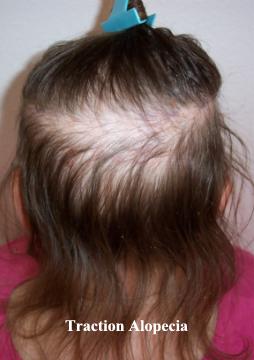dread tightening techniques like twisting, interlocking and to a lesser extent root rubbing and crocheting have hidden dangers, the most drastic of which is a condition known as traction alopecia which is becomming a big issue among african americans especialy.
corn rows, micriobraids, twisting dreadlocks cause a constant pulling and twisting pressure on the scalp wich results in permenant hair loss and scalp trauma
copied from traction alopecia.com
It might be strange to think of a 19 year-old female getting a hair transplant, but Kris Johnson of Atlantis Hair Transplant Clinic in Fort Lauderdale Florida says he is seeing an increase in the number of young women seeking hair transplants, most of them African-American.
The reason for the increase is Traction Alopecia , a hair loss condition caused by damage to the dermal papilla and hair follicle by constant pulling or tension over a long period. It often occurs in persons who wears tight braids, especially "cornrows" that lead to high tension, pulling and breakage of hair.
This condition is most common in African-American women and men who braid their hair too tightly. It is also common in Sikh men of India and Japanese women whose traditional hair styles also pull and damage hair. Traction alopecia occurs more frequently in children, teenagers and young adults then it does in older women and men.
Traction alopecia is reversible if diagnosed early, but may lead to permanent hair loss if it is undetected for a protracted period. Hair loss is often in the frontal and temporal regions, but also depends on the hair style.(1) With those who wear cornrows, the area most commonly affected is that adjacent to the region that is braided. (2)
Traction Alopecia can also occur due to overprocessing of the hair. Chemical treatment of hair with dyes, bleaches, or straighteners disrupts the keratin structure in a manner that reduces its tensile strength. (2) The hair can become fragile and heavy fall out can occur with brushing or combing.
The use of thermal or chemical hair straightening, and hair braiding or weaving are examples of styling techniques that place African American women at high risk for various "traumatic" alopecias. (3)
The key to stopping traction alopecia is detecting it early. Hair styles that put unnecessary strain on the hair root must be changed for "looser, more gentle hair style. Women, African-American women, who suspect they may be vulnerable to traction alopecia should take action immediately to change their hair style or treatment methods and by all means, take the time to see a dermitologist. Professional hair stylists specializing in braids, cornrows, weaving and chemical processing should warn their clients about traction alopecia.
Unfortunately, no medical treatment is available to reverse late-stage traction alopecia. Hair grafts have been identified as the only practical solution .
"We're seeing an increase in the number of young women who are coming to us for a hair transplant," Kris Johnson said. "Just the other day we did a hair transplant for a 19 year-old African-American girl. It's a shame really because she didn't have to lose her hair." (4)
Johnson said he's had good success in treating traction alopecia with hair transplants.
"Women and men with permanent traction alopecia make good candidates for hair transplants," he said. "Many of them are treated with hair transplant results I'd rate from Good to Excellent."
Summary Points:
-
In the USA, traction alopecia is most common in African-American women due to their hair styles. Can also occur in men who use hair weaving to conceal bald areas.
-
More common in children and young adults and less common in older adults.
-
Traction Alopecia is reversible if detected early but can lead to permanent hair loss. Early detection is the key.
-
For women, no medical treatment exists and hair grafts are their only option.
-
Traction alopecia is more common in the frontal and temporal regions, but also depends on the hair style. With cornrows, hair loss is adjacent to the rows.
-
Women and men who suspect they might be vulnerable to traction alopecia should change their hair style and/or reduce usage of hair chemicals, and consult their dermatologists.
-
Traction Alopecia is not related to excema, dandruff or dermatitis
pictures of traction alopecia
traction alopecia is easily prevented
easy steps to prevent traction alopecia in dreadlocks:
- never retwist dreads to tighten them, if you must do it very rarely and not at all tightly, but it is recomended to not retwist dreads ever
- never interlock dreadlocks. interlocking makes dreads too tight to the scalp causimg a constant pulling
- leave roots alone! let them dread on their own without putting unesacary stresses on the roots
--
My new book Ban The Taboo Vol 1
updated by @soaring-eagle: 01/13/15 08:58:35PM






